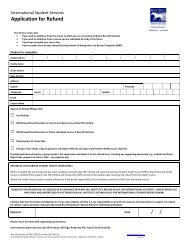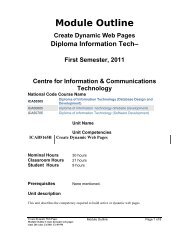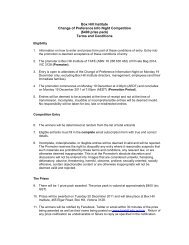PICAXE Manual Section 1 - TechnoPujades - Free
PICAXE Manual Section 1 - TechnoPujades - Free
PICAXE Manual Section 1 - TechnoPujades - Free
- No tags were found...
You also want an ePaper? Increase the reach of your titles
YUMPU automatically turns print PDFs into web optimized ePapers that Google loves.
www.picaxe.co.uk<strong>Section</strong> 1 98GETTING STARTEDHow does the <strong>PICAXE</strong> do ADC (analogue-to-digital) conversions?The <strong>PICAXE</strong>-08 and <strong>PICAXE</strong>-18 use the internal comparator to do a lowresolution ADC step comparison, providing 16 discrete analogue values. Theother <strong>PICAXE</strong> microcontrollers all use the internal ADC to do a full 256 step (8bit) conversion. Although the microcontrollers are technically capable of 10 bitconversions, this is converted by the readadc command into byte (8 bit) valuesfor ease of use via the byte (b1 etc.) variables, which makes the maths easier forstudents. This gives a resolution of about 0.02V (at 5V supply) which is adequatefor almost all educational projects. Most parts also have a separate 10 bit adcread option (1024 steps), via the readadc10 command.Can you supply the bootstrap program so that I can make my own <strong>PICAXE</strong>?No. The small royalty made on each <strong>PICAXE</strong> chip sold is the only financialbenefit to our company to support the <strong>PICAXE</strong> system - the software is free andthe cables/development kits are sold at very low cost. Therefore we do not allowanyone else to manufacture <strong>PICAXE</strong> microcontrollers.Can I mix assembler in with the BASIC code?No. The program and bootstrap code cannot be ‘mixed’ with assembler code, thisis not good programming practice. However you can achieve the same goal byconverting your BASIC into assembler code using the automatic conversionfeature, and then editing the converted assembler code program (see below).Can I see the assembler code that is downloaded into the <strong>PICAXE</strong>?If you own a Revolution Serial PIC Programmer (part BAS800), you can convert<strong>PICAXE</strong> BASIC programs into assembler code, to program blank PICs or to justlearn how assembler code works by 'disassembly'. However some of the morecomplex commands (e.g. serin) are not supported, and the assembler codeprogram generated is optimised for sequential learning (not optimised forcompactness as with the <strong>PICAXE</strong> system) and so the code is not identical to thatdownloaded to the <strong>PICAXE</strong>.Can you alter the input/output pin arrangement of the <strong>PICAXE</strong> microcontroller?The <strong>PICAXE</strong>-08 has 5 pins that can be configured as desired. The 28 and 40 pin<strong>PICAXE</strong> can also be altered to give more inputs or outputs. The 18 pin input/output pin arrangements are fixed and cannot be altered.How long a program can I download into the <strong>PICAXE</strong> microcontroller?This varies on the commands used, as not all commands use the same amount ofmemory.There is no fixed ‘byte’ formula as to memory usage e.g. pause 5, pause 50 andpause 500 will all take different amounts of memory space! To calculate memoryusage use the ‘Check Syntax’ option from the <strong>PICAXE</strong> menu. This will report theamount of memory used.Do symbols increase the program length?No, all symbols are converted back to ‘numbers’ by the computer software priorto download and so have no affect on program length. You can use as manysymbol commands as you wish.revolution(c) Revolution Education Ltd. Email: info@rev-ed.co.uk Web: www.rev-ed.co.ukVersion 6.9 07/2009All rights reserved.98
















